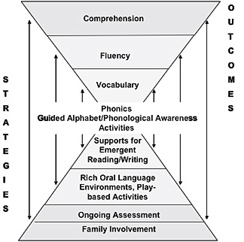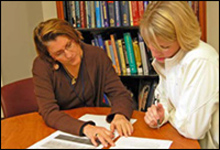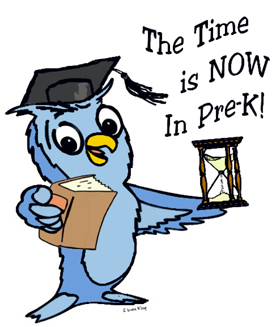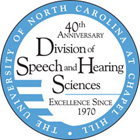Literacy
Early Reading First
”A unique part of the ERF program is that is has both a professional development component and an evaluation component.”
-Karen Erickson, PhD, David E. & Dolores J. Yoder Distinguished Professor, Division of Speech and Hearing Sciences, and Director, Center for Literacy & Disability Studies
Karen Erickson discusses the Early Reading First Program
Karen Erickson and Patsy Pierce have made a difference in the education of students in the Richmond County, NC, schools. Through a program funded by the U.S. Department of Education, the schools are using evidence-based strategies to improve the learning environment, including family involvement, a rich language environment, intentional phonological awareness, and alphabet experiences. The model for the Early Reading First (ERF) program is the Hourglass Model, an inclusive, integrated model of oral and written language development, assessment, and intervention.
The program is unique in that is has both a professional development component, which is led by Dr. Pierce, and an evaluation component, led by Dr. Erickson. UNC students are heavily involved in the program: over 4 years, 4 PhD students and 25 Masters in Speech-Language Pathology students have participated. Teaching assistants at the schools are also a critical part of each education team, and are given support for continuing education so they can get more advanced degrees. Assessments are held at the beginning and end of each year and the results have been exciting: students have shown more progress in 4 months than children normally would make in a whole year.
Program evaluation has shown that language competency needs to be developed beyond just learning basic skills. Language and communication develop most effectively in social interactions within the context of children’s daily activities and routines, with involvement by family, special educators, and early care providers.
The program will gradually include all teachers in the Richmond County school system. Teachers will be shown how to adapt the curriculum to work with children identified as being at-risk from pretest results. Erickson plans to continue tracking the students to demonstrate differences at various grade levels up through high school, to show that the early childhood emphasis of the ERF program has really had a long-term impact on the students.
Theoretical Framework
The Hourglass Model of Language and
Literacy Development, Assessment, and Intervention

Courtesy of Patsy Pierce
The research-based model that was developed and is being evaluated in this Early Reading First (ERF) project is an inclusive, integrated model of oral and written language development, assessment, and intervention called the Hourglass model. The selection of the Hourglass as the symbol for the model is based on three important factors:
![]() It represents the imperative, time-sensitive need for developing pre-Kindergarten (pre-K) children’s language and literacy skills.
It represents the imperative, time-sensitive need for developing pre-Kindergarten (pre-K) children’s language and literacy skills.
![]() It reminds us that without careful attention to the development of language and communication within all educational and social environments, the critical ”sands of time” will run out for young children with, and at risk for, literacy and language learning difficulties preparing for success in kindergarten and beyond.
It reminds us that without careful attention to the development of language and communication within all educational and social environments, the critical ”sands of time” will run out for young children with, and at risk for, literacy and language learning difficulties preparing for success in kindergarten and beyond.
![]() It provides a visual reminder of the connections of early language and literacy instructional strategies to conventional language and literacy outcomes.
It provides a visual reminder of the connections of early language and literacy instructional strategies to conventional language and literacy outcomes.
Time is running out in the hourglass of the preschool year, thus
“THE TIME IS NOW IN PRE-K”

Photo: Jackson Roush
Patsy Pierce, PhD, Assistant Professor, Division of Speech & Hearing Sciences, and Associate Director for Early Childhood Research and Practice, Center for Literacy and Disability Studies, works with Hillary Harper, PhD student, the Graduate Research Assistant for the ERF project
”The children in our project have made significant progress in their receptive vocabulary, expressive language, and alphabet knowledge….We have served over 100 children each year, 30% of whom have Individual Education Plans (IEPs), including children with significant communication needs.”
-Patsy Pierce

“Since 2001, North Carolina’s Department of Public Instruction (NC DPI) has supported Preschool Demonstration Programs (PDP). The purpose of these programs is to demonstrate effective oral and written language supports for preschool children in inclusive classrooms. As each program uses different curricula and curricular-based assessments of their choice, NC DPI wanted to create a unifying model so that impact effects of the program as a whole could be evaluated. The model had to unify yet reflect individual variation and the unique qualities of each of the programs. Through on-going dialogue and feedback from teachers, administrators, and visitors to the PDP, the Hourglass model of naturalistic language and literacy development, assessment, and intervention was developed. This model has been implemented over the past several years in the PDP and is currently being implemented and evaluated through Richmond County Schools’ Early Reading First (ERF) grant, “The Time is Now in Pre-K.”
The Time is NOW in Pre-K
Awarded to Richmond County Schools, NC Professional Development and Evaluation Provided by the Center for Literacy and Disability Studies, UNC-CH

Courtesy of Patsy Pierce
ERF Project: https://www.med.unc.edu/ahs/sphs/research/the-time-is-now


 Cochlear Implant
Cochlear Implant





